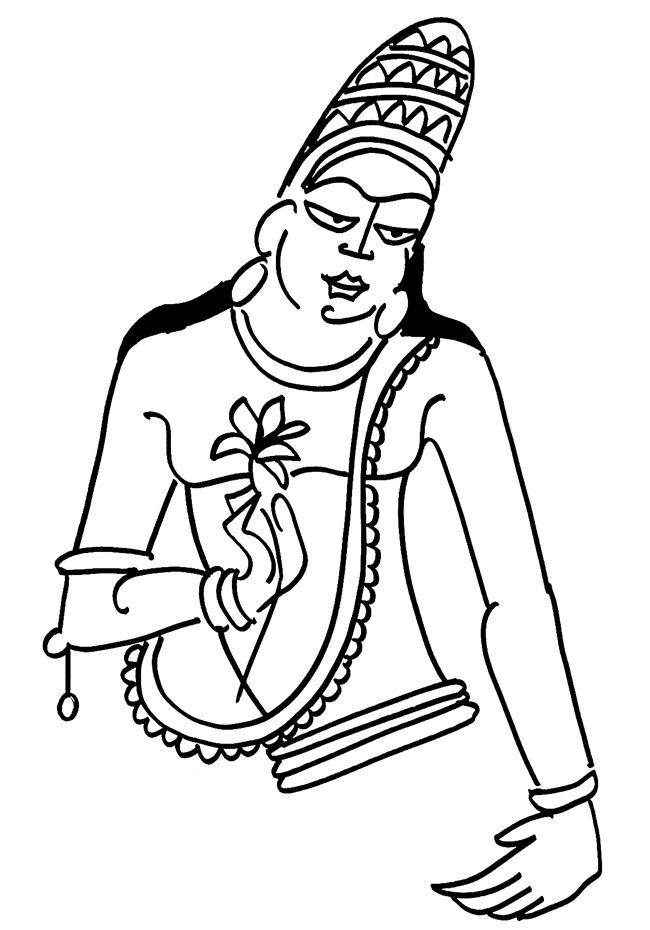No, this is not about political parties that use the lotus or the hand as their symbol. This is about Padmapani — he who bears the lotus, a Buddhist image from the Ajanta caves in Maharashtra that is among the earliest surviving artworks of India.

Illustration/Devdutt Pattanaik
 No, this is not about political parties that use the lotus or the hand as their symbol. This is about Padmapani — he who bears the lotus, a Buddhist image from the Ajanta caves in Maharashtra that is among the earliest surviving artworks of India.
No, this is not about political parties that use the lotus or the hand as their symbol. This is about Padmapani — he who bears the lotus, a Buddhist image from the Ajanta caves in Maharashtra that is among the earliest surviving artworks of India.
This image was painted about 1,600 years ago and remains among the earliest murals in Indian history. Painted by Buddhist monks inside a dark cave, one wonders why members of a monastic order would paint such beauty far from the beholder’s eye.
ADVERTISEMENT

Illustration/Devdutt Pattanaik
Perhaps such murals were also painted in public spaces, but could not survive history. All we have are images such as Padmapani to remind us of a bygone era expressing thoughts that are still relevant to us.
What is striking about Padmapani is the delicate grace of his form. Though a man, his posture is what we would call feminine today. It is called tri-bhanga, or a body curved at three points: the neck, the back and the hips. And then in one hand he carries the lotus flower. This is in striking contrast to the aggressive postures of warriors or even the serene postures of sages, often found in art. This bejewelled image is almost identified as a dancer, who discovered desire as the root cause of suffering.
But Padmapani is not of a Buddha; he is a Boddhisattva. About 500 years after Sakyamuni Buddha a Sanskrit scripture known as the Lotus Sutra appeared, which claimed it contained wisdom revealed by Buddha but was locked away in the realm of the nagas (subterranean serpents) until humanity was ready. In this book, Buddha never died and there is no single Buddha in the world. There are many immortal enlightened beings. Amongst them are the Bodhisattvas who postpone their enlightenment until all of humanity is relieved of all misery.
Avalokiteshwara (he who looks down from the heaven at suffering humanity) is one of them. Padmapani is a form of Avalokiteshwara. The Lotus Sutra became popular in China and there Avatilokeshwara came to be seen as the compassionate lady, Gwanyin. This may be traced to the androgynous nature of the Padmapani.
The story goes that one day, after his discourse, a member of the audience looked a bit confused and sought clarity. And so the Buddha simply picked up a lotus and that simple gesture invoked enlightenment to all those who paid attention. This symbolic communication was more powerful than a word-filled discourse. This form of Buddha later came to be associated with Padmapani.
The lotus is an ancient Indian symbol, one that has multiple, even paradoxical, meanings. It is associated with materialism (the source of honey for the bee). It is associated with spiritualism (rising beautifully from muck). It is an indicator of sexual desire (opening up when the sun appears). It is also an indicator of detachment (remains impervious to water). Still Padmapani’s gesture did not further confuse the already confused student. It perhaps helped him see the answer he was looking for.
The author is Chief Belief Officer of the Future Group, and can be reached at devdutt@devdutt.com
The views expressed in this column are the individual’s and don’t represent those of the paper.
 Subscribe today by clicking the link and stay updated with the latest news!" Click here!
Subscribe today by clicking the link and stay updated with the latest news!" Click here!







